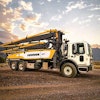It’s always best to check with your trowel manufacturer's maintenance guidelines to determine the best maintenance intervals for your equipment. However, here are a few tips to keep in mind.
Daily:
One of the most important daily maintenance items you can do to keep your trowel in tip-top shape is to instruct customers to power wash it at the end of each use. This will keep it looking professional and free from excess grease or other debris that might gum up moving parts. And your customers won't have to worry about dried concrete dropping onto their floor. For when the machine is back in your shop, there are cleaning solutions designed especially for removing dried-on concrete as well as products you can apply to your trowel to make it easier to clean at the end of each rental.
Greasing and maintenance checks can be easily performed after each use. This will ensure your trowel is ready to go for the next customer.
The concrete slab is a tough environment for your trowel engine, and it's important to make sure you're taking a look at the engine components every day. One of the most common problems is not checking the air filters. Concrete dust will choke the engine the machine will not operate at the optimal power level.
Examine the air filter every day for potential clogging. With a liquid-cooled engine you'll want to check your coolant level daily. On all engines you should check the oil level and for oil leaks.
Before turning on the machine, the operator should perform a visual inspection making sure the bolts that attach to the blades are tight and the safety guards are in place.
Weekly:
Weekly inspections emphasize a closer look at your trowel's bottom end. A bent spider arm - the part of the trowel that holds the blades or pans - can result in a swirling pattern or waviness to the finish. An experienced operator can recognize these problems during operation, but noticing these problems during a job can often be too late to fix them in time to save the slab without re-work. Most manufactures offer spider assemblies with adjustable arms. This allows you to compensate for a bent arm and ensure your blades are all working on the same plane.
Another maintenance item you should add to your weekly checklist concerns the drive belt. Rubber drive belts will disintegrate with heat. Make sure your trowel's belt is in good condition, and change it when you begin to notice wear.
Monthly:
Monthly maintenance items take a step beyond your daily engine maintenance checks. In other words, while you're checking oil levels and air filters or coolant daily, you should plan on monthly replacement or cleaning. Be sure to examine your engine manufacturer's recommendations to determine the best engine maintenance schedule. Not all engines are the same - air-cooled engines will generally need more frequent oil changes than liquid-cooled engines.
Another engine feature designed for easy maintenance is an oil alert system, which notifies the operator if the engine oil level drops below a safe operating level.
Before changing the oil, it’s always best to run the engine for two or three minutes to warm it up before changing the oil. Warm oil drains better and faster, plus running it before changing the oil will help remove more of the debris that is suspended in the oil. Check your engine manufacturer's recommendations for oil type and weight.
When it comes to buying coolant for your engine, be sure to read the labels. With the number of coolant blends available on the market, you might think you're buying a blend when you're actually buying a straight coolant. And never think straight water is going to cut it for a hard-working trowel.
Annual:
In addition to routine maintenance, there are a few annual checks you'll want to add to your maintenance schedule. Again, based on your manufacturer's suggestion for annual use, which is typically considered 300 to 500 hours of use, these are items you might end up doing once a year or a few times a year.
One annual maintenance item is changing your gear box oil. There's a lot of friction in these gear boxes and a little bit of wear on those gears. You will want to remove the metal out of the box or it's going to accelerate wear inside the gear box.
You should also pull out your blade arms and ensure proper adjustment, plan on replacing belt drives at least once a year, and closely examine your trowel's blade-tilt mechanism. With walk-behind trowels, annual maintenance on the throttle cable is critical. Use a synthetic grease in the throttle cable, which tends not to attract water as much as a petroleum-based oil can.


















